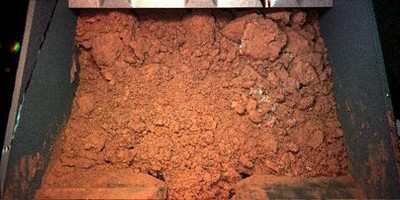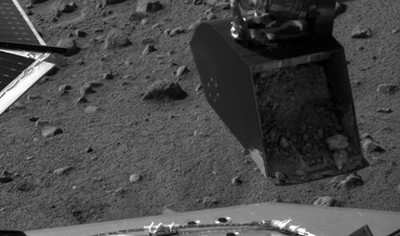Tue, Jun 10, 2008
Just A Little Sprinkle Might Do It
A revised method for delivering soil samples by the Robotic Arm
to laboratory instruments on NASA's Phoenix Mars Lander may yield
some success to failed earlier efforts now that researchers
appreciate how clumpy the soil is at the landing site.

"We're a little surprised at how much this material is clumping
together when we dig into it," said Doug Ming a Phoenix science
team member from NASA's Johnson Space Center, Houston.
As reported Sunday by ANN,
Phoenix’s instruments showed a vibrator on the screen --
designed to help shake soil into the chamber -- was working. But
the electronic sensor to detect dirt falling into the Thermal and
Evolved-Gas Analyzer (TEGA) chamber didn't report any
particles.
The TEGA is designed to bake and sniff samples to identify some
key ingredients central to the focus of the mission to determine if
the northern permafrost region may have the ability to support
life. The analyzer vibrated the screen for 20 minutes on Sunday but
detected only a few particles of the challenging soil getting
through the screen, not enough to fill the tiny oven below.

"We are going to try vibrating it one more time, and if that
doesn't work, it is likely we will use our new, revised delivery
method on another thermal analyzer cell," said William Boynton of
the University of Arizona, lead scientist for the instrument.
The initial method of delivery to get the first sample to TEGA
on Friday required the arm to turn the scoop over and release
it’s contents at once. A revised method requiring the arm to
hold the scoop at an angle above the delivery target and sprinkle
out a small amount of the sample by vibrating the scoop with a
motorized rasp at the bottom was to be attempted Monday.

Sunday, Phoenix used the arm to collect a soil sample for the
spacecraft's Optical Microscope. Monday’s plans included a
practice of the sprinkle technique, using a small amount of soil
from the sample collected Sunday.
If that goes well, the Phoenix team assembled at the University
of Arizona plans to sprinkle material from the same scoopful onto
the microscope later this week.
More News
Airport Rotating Beacon A visual NAVAID operated at many airports. At civil airports, alternating white and green flashes indicate the location of the airport. At military airports>[...]
Aero Linx: Fly for the Culture Fly For the Culture, Inc. is a 501(c)(3) non-profit organization that serves young people interested in pursuing professions in the aviation industry>[...]
Klyde Is Having Some Issues Comprehending The Fed's Priorities FMI: www.klydemorris.com>[...]
Also: Viasat-uAvionix, UL94 Fuel Investigation, AF Materiel Command, NTSB Safety Alert Norges Luftsportforbund chose Aura Aero's little 2-seater in electric trim for their next gli>[...]
Also: EP Systems' Battery, Boeing SAF, Repeat TBM 960 Order, Japan Coast Guard H225 Buy Despite nearly 100 complaints totaling millions of dollars of potential fraud, combined with>[...]
 ANN's Daily Aero-Term (04.25.24): Airport Rotating Beacon
ANN's Daily Aero-Term (04.25.24): Airport Rotating Beacon ANN's Daily Aero-Linx (04.25.24)
ANN's Daily Aero-Linx (04.25.24) Klyde Morris (04.22.24)
Klyde Morris (04.22.24) Airborne 04.24.24: INTEGRAL E, Elixir USA, M700 RVSM
Airborne 04.24.24: INTEGRAL E, Elixir USA, M700 RVSM Airborne 04.22.24: Rotor X Worsens, Airport Fees 4 FNB?, USMC Drone Pilot
Airborne 04.22.24: Rotor X Worsens, Airport Fees 4 FNB?, USMC Drone Pilot





